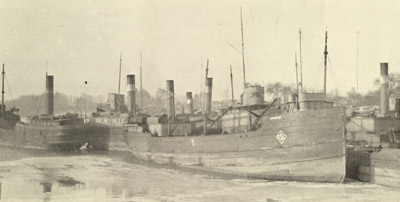Table of Contents
| Title Page | |
| Meetings | |
| The Editor's Notebook | |
| Marine News | |
| Ship of the Month No. 24 Maplehurst | |
| A Passenger On A Cargo Ship | |
| Special Offer For T.M.H.S. Members | |
| Coal to Newcastle? | |
| Table of Illustrations |
There are a few lake steamers that seem to have done a very good job over the years, of avoiding the cameras of those who would preserve an image of the lake shipping scene on film. One such vessel was the small steel bulk carrier MAPLEHURST. Although she operated under this name for about four years, your editor knew of no photograph of her (apart from ones showing her wreck in Lake Superior) until the one reproduced on this month's photopage was discovered recently. Perhaps this would be a good time to recount the story of MAPLEHURST.
The vessel was built in 1892 at South Chicago, Illinois, for the Cleveland Cliffs Iron Company. Christened CADILLAC, she was the first of three steamers in the Cleveland Cliffs fleet to bear this name. She was given a length of 230'0, a beam of 37' 2 and a depth of 15'3. Her tonnage was registered as 1263 Gross and 1068 Net. Constructed of a size suitable for operation in the Welland and St. Lawrence Canals, she spent much of her time in the iron ore trade out of Marquette, Michigan, to lower lake ports.

The elusive MAPLEHURST in winter quarters with other veteran C.S.L. steamers at Port Dalhousie, c. 1920. Photo courtesy Bill Bruce.
The vessel wore the dark red hull colour that the company used for many years and her cabins were painted dark olive, a colour still used by Cliffs, Originally, she may have carried a white forecastle, since some of the fleet units were so painted, but we have not seen a photograph to confirm this. Around 1912, CADILLAC was given a black hull as were all other Cliffs bulk carriers.
CADILLAC was sold in 1912 to Roy M. Wolvin for his Canadian Interlake Line which, the following year, became part of the newly-formed Canada Steamship lanes Ltd., Montreal. About this time, she was equipped with three swivelling cranes mounted on the starboard side of the deck. She was thus able to carry such cargoes as steel products and could also fill in on the Montreal to Fort William package freight run when required.
About 1919, CADILLAC was renamed MAPLEHURST by C.S.L. to conform with their policy of renaming a number of their ships using the prefix "Maple" while denoting the type of carrier with the first letter of the second syllable, i.e. "B" for package freighters (such as MAPLEBORO), "G" for wooden bulk carriers (as in MAPLEGLEN), and "H" for steel bulk carriers, generally of the lower lake variety (MAPLEHILL, etc.).
During 1921 and 1922, MAPLEHURST visited Toronto harbour on numerous occasions, sometimes with bulk coal cargoes, and sometimes with package freight.
The last voyage of MAPLEHURST's thirty year career began when she loaded coal at Lorain for delivery at the Canadian Lakehead city of Port Arthur late in November 1922. After leaving the shelter of the upper St. Mary's River, she encountered very heavy weather on her trip across Lake Superior. When off the Keweenaw Peninsula, her Master, Capt. L Menard (who had moved up to MAPLEHURST in 1921 from the wooden steamer INDIA) decided to seek shelter in the Keweenaw Waterway, a protected channel cutting through the middle of the Peninsula and formed in part by Portage Lake.
Capt. Menard accordingly altered course southwards so as to enter the western end of the waterway. While approaching the Portage Entry breakwater in the darkness of the evening hours of November 30th, the vessel became unmanageable. Flares were sent up and the distress signal was sounded on the whistle. The U.S. Coast Guard crew at the Portage Entry Station saw the distress signals and immediately put out in their surf boat. After making numerous attempts to get close alongside the steamer, they succeeded in removing nine crew members, but eleven more chose to remain with the doomed MAPLEHURST.
The Coast Guard boat took the rescued men to shore but, before it could return, MAPLEHURST stranded about 350 yards west of the upper entrance west breakwater and was completely at the mercy of the seas. The wreck took such a terrific pounding from the waves that by dawn of the next day, December 1st, all her deckhouses had been carried away, leaving only the deck cranes, funnel, and part of the boiler house in position. All eleven men who chose to stay with the ship perished during the night.
As the wrecked hull was severely damaged by the pounding she took on the rocky shore on which she had grounded, MAPLEHURST was abandoned to the underwriters as a total loss. The Dominion Wreck Commissioner placed a figure of $122,000 on the value of the ship and cargo.
(Ed. Note: For the rare photo of MAPLEHURST, we are indebted to member Bill Bruce who supplied a print from a negative kindly loaned by James Braniff of St. Catharines, Now we wonder how many of our readers can identify all the other vessels wintering in Port Dalhousie upper harbour in the picture.)
Previous Next
Return to Home Port or Toronto Marine Historical Society's Scanner
Reproduced for the Web with the permission of the Toronto Marine Historical Society.